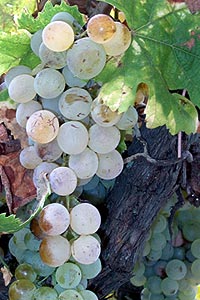
|
 |
| Bellone White grapevine common in Lazio,
particularly near Rome. It has several synonymous names:
Cacchione, Pampanaro, Bellobuono, Uva Pane, Zinnavacca,
Arciprete, Pacioccone. Its leaf is great, pentagonal and
palmate; its middle conic-shaped clustered or very clustered
grape sometimes with a winged structure, consists of smooth-skinned,
thick, yellowish- brownish, rounded berries. It is has
a rich pruina a soft pulp and a simple taste. This is
a vigorous and prolific plant even if not very constant.
It resists well the cryptogamian diseases and the bad
climatic conditions.
It produces a lot of must and it has to be considered
a typical vineyard of the Castelli Romani’s area.
It is very important for a typical and quality viticulture.
As a prolific variety it has to be cultivated on fresh
and fertile soils. It has to be pruned very often to improve
the production.
Average characteristics of the grape:
Average weight: 375 grams
Weight of 100 berries: 306 grams
Grape stalks’ percentage: 3,16%
Berries’ percentage: 96,84%
|
|
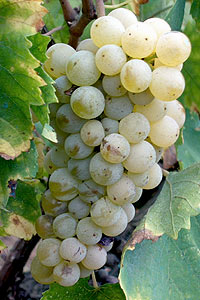
|
 |
| White Bonvino
A vineyard
to be considered among those who gives typical characteristics
to wine. In the past it was cultivated also to be eaten.
It gives to wine a full bodied and harmonic taste. This
very prolific plant has a middle vegetative vigour. It
is also known as “Ottonese” in the area near
Tivoli.
This grapevine is widely spread in Southern Italy, particularly
in Puglia, but also in Emilia Romagna, Lazio, Marches
and Abruzzi, where it is named “Trebbiano d’Abruzzo”.
Its other synonymous names are: Pagadebiti and Straccia
Cambiale (Emilia Romagna), meaning “to get out of
debt”, for it is a very prolific plants. Its leaf
is middle, hastate or palmate. Its middle, conic-shaped
grape sometimes with a winged structure, consists of smooth-skinned
yellowish- greenish rounded berries with brown spots.
If utilized with other vineyards, produces neutral and
not very interesting wines. If its vinification is accurate
it produces quality wines which can be stored for long
time. Thanks to this property, the Bonvino Bianco is gradually
increasing. If its wine is stored in adapt environment
will be drunk till November. This vineyard resists to
the cryptogamian diseases and bad climatic conditions.
It has to be pruned short.
Average characteristics of the grape:
Average weight: 323 grams
Weight of 100 berries: 282 grams
Grape stalks’ percentage: 4,28%
Berries’ percentage: 95,72%
|
|
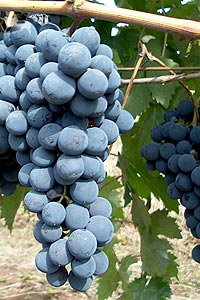
|
 |
| Cesanese comune
The word “Cesanese”
does not mean coming from Cesena but coming from Cesano
a place near Rome. It is a very important vineyard within
the wine production in Lazio. According to experts probably
it could belong to the “Alveoli” referred
to by Plinio as rich sources for red wines production
in the Ariccia’s Area.
Some years ago it was really widespread in the Castelli
Romani’s area, and as the only red vineyard it was
very appreciated from local consumers. The peronospora,
a disease which attacked it very often, and the increased
demand for white wines reduced the presence of this vineyard
in the territory, even if more than 49 Lazio’s wines
are still produced with it.
It is possible to distinguish two different varieties
of Cesanese: the Cesanese Comune and its sub-variety,
i.e. the Cesanese di Affile, particularly planted in the
territories of Piglio, Olevano Romano and Affile. These
two vineyards have slightly differences in ampelographic
characteristics and in the quality of the wine they produce.
The Cesanese is cultivated in the Castelli Romani’s
area in the territories of Velletri, Lanuvio, and Marino.
This grapevine has blackish berries and palmate middle
leaves. Its middle conic grape, sometimes with a winged
structure is clustered or very clustered. The berries
are oval, with a thick black-violet skin, which is very
hoary. This plant flowers late, it has a middle vegetative
vigour, and is very prolific in a constant way.
The Cesanese di Affile is less vigorous, and smaller grapes. |
|
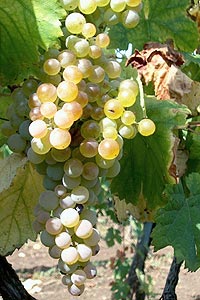
|
 |
Malvasia nostrale,
del Lazio or Puntinata
This is a very ancient and widespread vineyards in the Castelli
Romani’s area, that has been gradually abandoned due
to the fact that it is not a very prolific plant.
Its vinification characteristics mark it has a main element
to typify wines. The wine it produced is golden yellow,
and if utilized with other varieties gives to wine a round
taste without tang.
It has to be considered an important vineyard, producing
a white sweet wine. Its grape is not very clustered, and
can be cultivated with biotechnologies, which utilizing
particular products cannot be used vineyards with very clustered
grapes, easy attacked by funguses.
This vineyard has a middle vegetative vigour, short internodes,
and it buds and flowers late. Its leaves are smooth on the
surface and glabrous on the other side. Its middle pyramidal
grape has middle berries with an hoary and thick skin.
Its characteristic is a black spot at the centre of the
berry and therefore it is said “puntinata”,
meaning with a spot.
Its pulp is not very juicy and therefore it does not produce
a lost of must. It is ripe in third period and it has to
be pruned leaving a middle length.
Average characteristics of the grape:
Average weight: 310 grams
Weight of 100 berries: 253 grams
Grape stalks’ percentage: 2,24%
Berries’ percentage: 97,76% |
|
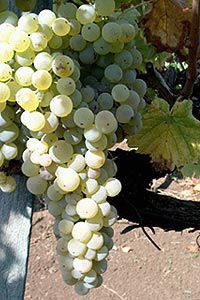
|
 |
Yellow Trebbiano
The classical vineyard of the Castelli Romani’s area,
i.e. the most widespread and the most utilized as basis
for white wines production. It has a lot of synonymous names:
Greco (Velletri, Cori, Zagarolo); Trebbiano dei Castelli
(Nettuno); Greco Giallo or Rossetto.
It is a vigorous grapevine with internodes having blakish
spots; its middle leaves are reniform, dark greenish and
rugose on the surface and whitish on the other side.
Its clustered grapes have small, rounded, thick-skinned
berries, that when ripe, have a golden yellow colour. It
is ripe in third period.
It resists well the oidium and the peronospora. It has to
be pruned leaving a long length as the buds giving fruits
are in the central part of the trailing branches.
Average characteristics of the grape:
Average weight: 273 grams
Weight of 100 berries: 212,50 grams
Grape stalks’ percentage: 3,33%
Berries’ percentage: 96,67% |
|
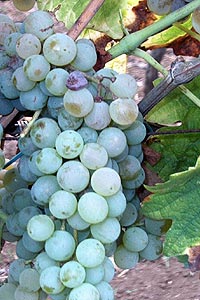
|
 |
Green Trebbiano
It is a vineyard very similar to the Verdicchio di Jesi
and Matelica in the Marches. It was very widespread in the
Lazio’s Hills in 1800 when it was used with other
varieties in a low percentage: 7-8%.
It is less vigorous than the yellow Trebbiano, it has short
internodes. Its leaves are palmate and yellow-greenish in
Autumn.
Its conic grape has small, spherical, greenish berries with
a thin skin and not very hoary.
It is ripe in third period, it suffer from oidium’s
attacks and it has to be pruned leaving a long trailing
branch.
It is less prolific than the Yellow Trebbiano if it is used
to produce whites through wines with a characteristic greenish
colour.
This vineyard produces a wine perfect for lunchtime, whose
quality is very high. Its colour is straw yellow, quite
greenish. Its very pleasant taste is crisp.
It has to be considered as an important variety among Castelli
Romani’s vineyards; it has the quality of characterizing
and typifying the oenological productions of the Castelli
Romani.
Average characteristics of the grape:
Average weight: 242 grams
Weight of 100 berries: 152 grams
Grape stalks’ percentage: 3,66%
Berries’ percentage: 96,34% |
|
|
 |
|

